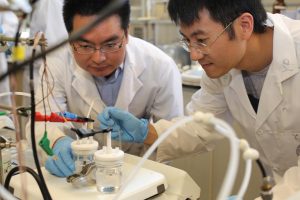Scientists from the University of Toronto (U of T) have discovered a way to turn carbon dioxide (CO2) into renewable fuels and chemicals through nanoengineering. Led by Professional Ted Sargent, Min Liu, PhD. and Yuanjie Pang, PhD, along with a team of graduate students and post-doctoral fellows in U of T Engineering, have developed a technique powered by renewable energies such as solar or wind. The catalyst takes CO2 and converts it to carbon-monoxide (CO). From there, the gas can be used to create carbon-based chemical fuels, such as methanol, ethanol and diesel. Their work is published in the journal Nature.

U of T Engineering researchers Min Liu (left), Yuanjie Pang and their team designed a way to efficiently reduce climate-warming carbon dioxide into carbon monoxide, a useful chemical building block for fuels such as methanol, ethanol and diesel. Photo Credit: MARIT MITCHELL, U OF T ENGINEERING
CO2 reduction is an important challenge due to the inertness of the molecule.”We were looking for the best way to both address mounting global energy needs and help the environment,” said Pang. “If we take CO2 from industrial flue emissions or from the atmosphere, and use it as a reagent for fuels, which provide long-term storage for green energy, we’re killing two birds with one stone.”
The process begins with the fabrication of extremely small gold “nanoneedles” — the tip of each needle is 10,000 times smaller than a human hair. The nanoneedles act like lightning rods for catalyzing the reaction. When the research team applied a small electrical bias to the array of nanoneedles, they produced a high electric field at the sharp tips of the needles. This helps attract CO2, speeding up the reduction to CO, with a rate faster than any catalyst previously reported. According to Liu and Pang, this represents a breakthrough in selectivity and efficiency which brings CO2 reduction closer to the realm of commercial electrolysers. The team is now working on the next step: skipping the CO and producing more conventional fuels directly.
“The field of water-splitting for energy storage has seen rapid advances, especially in the intensity with which these reactions can be performed on a heterogeneous catalyst at low overpotential — now, analogous breakthroughs in the rate of CO2 reduction using renewable electricity are urgently needed,” said Michael Graetzel, a professor of physical chemistry at École Polytechnique Fédérale de Lausanne and a world leader in this field. “The University of Toronto team’s breakthrough was achieved using a new concept of field-induced reagent concentration.”
The research represents not only a new solution to a longstanding problem of CO2 reduction but opens the possibilities for storage of alternative energies such as solar and wind.

